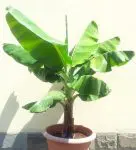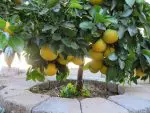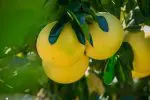This post contains affiliate links. If you buy something from one of our links we may earn a commission. Thanks
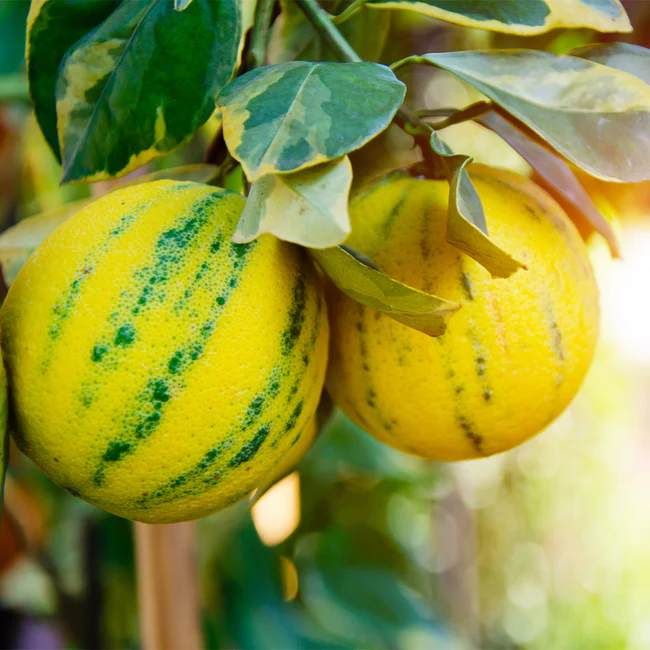
Are you ready to bring the sweet and tangy flavor of fresh lemons to your own home or backyard?
Growing a Dwarf Eureka Lemon Tree is a great way to do just that.
To grow a Dwarf Eureka Lemon Tree indoors, use well-draining soil, ensure 8-12 hours of sunlight daily, and water when the top inch of soil feels dry. Fertilize with a balanced, all-purpose fertilizer every 6-8 weeks during growing months. Regular pruning helps maintain its shape and size.
With their compact size, these dwarf trees are perfect for small gardens and patios.
With only 7 easy steps, even beginners can successfully grow their own lemon tree.
Whether you’re a first-time gardener or a seasoned green thumb, this guide will walk you through the process of how to grow Dwarf Eureka Lemon Tree in a cooler climate from start to finish, so you can enjoy the juicy, delicious fruit in no time.
What is a Dwarf Eureka Lemon Tree?
A Dwarf Eureka Lemon Tree is a variety of lemon tree that is much smaller in size compared to standard lemon trees like Meyer lemons.
It typically grows to be only 6-10 feet tall, making this small tree an ideal choice for small spaces such as patios, balconies or even indoor gardens.
Despite its small size, a Dwarf Eureka Lemon Tree produces large, juicy, and delicious lemons, making it a great choice for home gardeners.
For indoor citrus growers dwarf varieties of citrus plants are the best choice as these young trees will be much easier to control.
You can apply the steps in this article to growing a dwarf Meyer lemon tree indoors too.
Benefits of growing Dwarf Eureka Lemon Trees
• Space-saving: As mentioned, the Dwarf Eureka Lemon Tree’s compact size makes it perfect for indoors, small gardens, and patios, making it an ideal choice for those with limited outdoor space.
• Fresh lemons: With a Dwarf Eureka Lemon Tree in your backyard, you’ll have a constant supply of fresh lemons to use for cooking, baking, and even for making your own homemade lemonade.
• Decorative: The Dwarf Eureka Lemon Tree is an attractive plant that adds beauty and fragrance to your garden or patio. It has glossy green leaves, fragrant white flowers, and yellow fruit that provide a great contrast.
• Nearly Thornless: Most lemon trees have thorns but the Eureka Lemon has very few thorns.
An Overview Of The 7 Easy Steps To Grow Dwarf Eureka Lemon Trees
• Choose The Right Eureka Lemon Tree
• Choose the Right Location
• Prepare the Soil
• Select the Right Container
• Obtain a Dwarf Eureka Lemon Tree
• Plant the Dwarf Eureka Lemon Tree
• Provide Proper Care
These 7 steps will guide you through the process of growing a Dwarf Eureka Lemon Tree from start to finish, ensuring that you’ll be able to successfully grow a healthy and productive tree.
Whether you’re a first-time gardener or a seasoned green thumb, this guide will help you bring the sweet and tangy flavor of fresh lemons to your own backyard.
Step 1: Choose A Pink Variegated Eureka Lemon Tree
The Pink Variegated Eureka Lemon Tree is a variety of the Dwarf Eureka Lemon Tree that is known for its unique and striking appearance.
The variegated pink lemon, also called the variegated Eureka lemon, or pink-fleshed Eureka lemon is a cultivar of lemon (Citrus × limon) with unique pink flesh, a green-striped rind when ripening, and variegated foliage. It was discovered as a sport on an ordinary Eureka lemon tree in Burbank, California, in 1931. https://en.wikipedia.org/wiki/Variegated_pink_lemon
This lemon tree has leaves that are variegated with white and green stripes, and it produces large, juicy lemons that have bright pink flesh.
These lemons are not only beautiful to look at, but they also have a sweet, tangy flavor that is perfect for cooking, baking, and making drinks.
Like the Dwarf Eureka Lemon Tree, the Pink Variegated Eureka Lemon Tree is small in size, making it an ideal choice for small spaces such as patios, balconies, or indoor gardens.
The tree is also low maintenance and easy to grow, making it a great choice for both experienced and beginner gardeners.
If you’re looking for a lemon tree that is both functional and beautiful, the Pink Variegated Eureka Lemon Tree is definitely worth considering.
With its variegated leaves, fragrant flowers, and sweet, juicy fruit, this tree is sure to become a focal point in your indoor garden or patio.
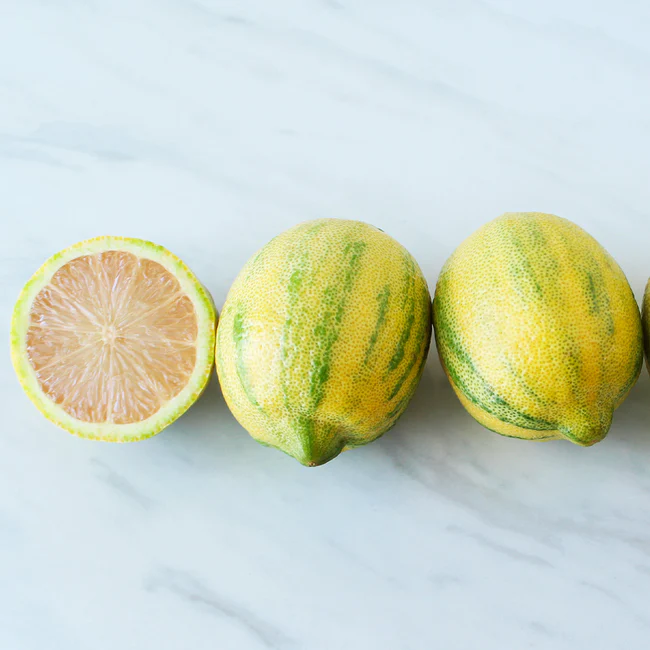
Step 2: Choose the Right Location
The Dwarf Eureka Lemon Tree thrives in warm, sunny locations, and it is important to choose a location that provides plenty of sunlight for your tree to grow and for fruit production.
A location that receives at least 6-8 hours of direct sunlight per day is ideal for a Dwarf Eureka Lemon Tree. Full sun is just fine for most citrus fruits.
Factors to Consider
When choosing a location for your Dwarf Eureka Lemon Tree, it is important to consider several factors, including:
• Sunlight: As mentioned, a location that receives at least 6-8 hours of direct sunlight per day is ideal for a Dwarf Eureka Lemon Tree.
• Temperature: The Dwarf Eureka Lemon Tree prefers warm temperatures, and it is best to choose a location that is protected from cold winds and frost.
• Soil Drainage: The Dwarf Eureka Lemon Tree needs well-draining soil, so it is important to choose a location that is not prone to standing water or heavy soil moisture.
By considering these factors, you can ensure that you choose the right location for your Dwarf Eureka Lemon Tree and that your tree will have the best chance of thriving and producing juicy, delicious fruit. Read on for special instructions if growing indoors.
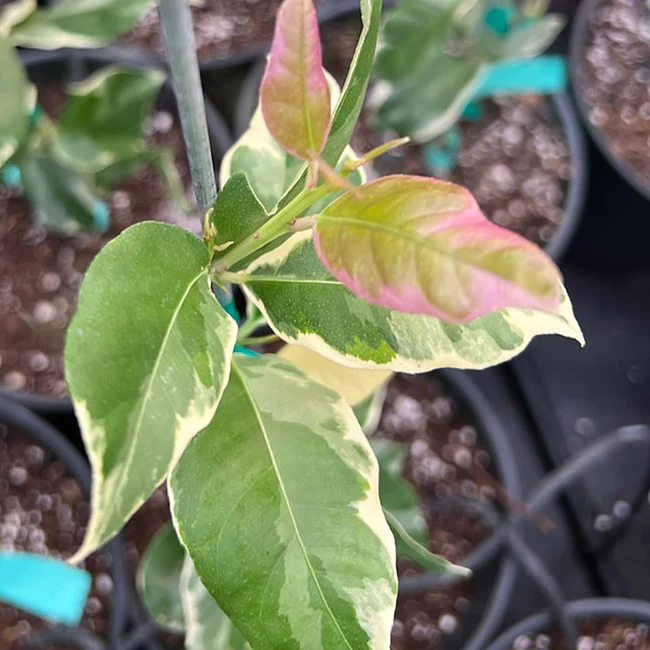
What Is The Right Location For Growing A Dwarf Eureka Lemon Tree Indoors?
If you’re growing a Dwarf Eureka Lemon Tree indoors, it is important to choose a location that provides plenty of sunlight.
A sunny window that faces south or southwest is ideal, as this will provide your tree with the maximum amount of direct sunlight.
If you do not have a sunny window, you can also use grow lights to provide your tree with the necessary light.
In addition to sunlight, it is also important to choose a location that has a consistent temperature, as the Dwarf Eureka Lemon Tree prefers warm temperatures.
A room with a temperature between 60-85°F is ideal for an indoor Dwarf Eureka Lemon Tree.
When choosing a location for your indoor Dwarf Eureka Lemon Tree, it is also important to consider the tree’s mature size, as well as the space you have available.
A Dwarf Eureka Lemon Tree typically grows to be only 6-10 feet tall, but it still needs enough room to grow and spread its branches.
It can be kept smaller with pruning and this tree responds well to pruning as do most other dwarf citrus trees.
Moving Your Dwarf Lemon Tree Outdoors
You don’t need to keep your tree indoors year-round and you can move it in and out with the seasons.
The Eureka lemon does well outdoors in USDA hardiness zones 9 and 10 and thrives well in warmer climates.
But you can move your plant outdoors in early spring.
Consider using a planter caddy on wheels so you can easily move your lemon tree outdoors when the weather warms and back in again when it starts getting cold.
Your tree is not cold hardy but can withstand a light frost for a few hours but cold temperatures in the 20s can harm or kill it.
 By considering these factors, you can ensure that you choose the right location for your indoor Dwarf Eureka Lemon Tree and that your tree will have the best chance of thriving and producing juicy, delicious fruit.
By considering these factors, you can ensure that you choose the right location for your indoor Dwarf Eureka Lemon Tree and that your tree will have the best chance of thriving and producing juicy, delicious fruit.
Step 3:Prepare the Soil
For both indoor and outdoor Dwarf Eureka Lemon Trees, well-draining soil is essential. The ideal soil type for Dwarf Eureka Lemon Trees is a well-draining, slightly acidic soil that is rich in organic matter. This type of soil will help to prevent root rot and provide your tree with the necessary nutrients to grow and produce fruit.
Ideal Soil For Growing Citrus Indoors
For indoor Dwarf Eureka Lemon Trees, it is important to use a high-quality, well-drained soil mix.
You can use a potting mix specifically formulated for citrus trees, or use a mix that contains a blend of peat moss, perlite, and vermiculite.
I have found a mix of coco coir and perlite works exceptionally well for citrus trees and provides good drainage. I use about 30-50 % perlite in the mix.
More perlite will increase drainage but will also require more frequent watering.
I like to mix worm castings in with the coco coir but you can use compost or a slow-release organic fertilizer too. too.

I recommend using Jobes Organics fertilizer spikes.
They are easy to use and last for 2-3 months.
They are designed for container-grown citrus.
Using 2 spikes for a 12-inch pot or 3 for an 18-inch pot takes the guesswork out of fertilizing.
They provide a 3-5-5 fertilizer blend along with micronutrients and beneficial bacteria.
When planting an indoor Dwarf Eureka Lemon Tree, be sure to choose a container that is large enough to accommodate the tree’s root system.
A container with drainage holes is also important, as this will help to prevent root rot by allowing excess water to drain away from the roots.
In addition to using the right soil, it is also important to ensure that your indoor Dwarf Eureka Lemon Tree has adequate water and nutrition.
A balanced, slow-release fertilizer specifically formulated for citrus trees can provide the necessary nutrients, and it is important to water your tree regularly, but not over-water, to ensure that the soil remains consistently moist but not waterlogged.
By taking these steps, you can ensure that your indoor Dwarf Eureka Lemon Tree has the best growing conditions, and that it will thrive and produce juicy, delicious fruit.
Step 4: Select the Right Container for Indoors
For indoor Dwarf Eureka Lemon Trees, it is important to choose a container that is large enough to accommodate the tree’s root system.
A container with a capacity of 5-10 gallons is ideal for a Dwarf Eureka Lemon Tree, as this will provide enough room for the roots to grow.
In terms of material, terra cotta containers are popular choices, as they are durable and breathable, which helps to prevent root rot.
However, plastic containers are also an option, as they are lightweight and easy to move. Just make sure that the container has drainage holes to allow excess water to drain away from the roots.
Factors to Consider When Choosing a Container
When choosing a container for your indoor Dwarf Eureka Lemon Tree, there are several factors to consider:
• Drainage: Make sure the container has drainage holes to prevent water from pooling at the bottom, which can lead to root rot.
• Size: Choose a container that is large enough to accommodate the tree’s root system, but not so large that the soil stays constantly wet.
• Material: Choose a container that is durable and breathable, such as terra cotta or a lightweight plastic container.
By considering these factors, you can choose the right container for your indoor Dwarf Eureka Lemon Tree, and ensure that it has the best growing conditions.
Step 5: Obtain a Dwarf Eureka Lemon Tree
Where to Purchase a Dwarf Eureka Lemon Tree?
Dwarf Eureka Lemon Trees are available from a variety of sources, including online retailers, garden centers, and specialty nurseries.
When purchasing a Dwarf Eureka Lemon Tree, it is important to choose a reputable source to ensure that you get a healthy, vigorous tree.
How to Select a Healthy Tree
When selecting a Dwarf Eureka Lemon Tree, there are several things to look for:
• Vigor: Choose a tree with strong, healthy growth, and no yellowing or drooping leaves.
• Root System: Check the roots to make sure they are healthy and not pot-bound, or tightly packed in the container.
• Trunk and Branches: Look for a straight, sturdy trunk and evenly spaced branches, with no signs of cracking or damage.
• Foliage: The leaves should be glossy, with a deep green color, and free of any yellowing, browning, or spots.
By following these tips, you can select a healthy Dwarf Eureka Lemon Tree, and set yourself up for success as you begin your journey as a lemon tree grower.
If you are buying your tree online you will not be able to visually inspect it so it is important to buy it from a reputable online nursery that offers a money-back guarantee if it dies.
Step 6: Plant the Dwarf Eureka Lemon Tree
When planting your indoor Dwarf Eureka Lemon Tree, it is important to follow these steps:
• Fill the Container: Fill the container half full with good quality, well-draining potting mix.
• Remove Tree from Pot: Carefully remove the tree from its pot, being careful not to damage the root system. You can trim back broken or damaged roots.
• Plant At The Same Level: Don’t plant your tree deeper than it was grown in the nursery.
• Place Tree in Container: Place the tree in the center of the container, and backfill the potting mix around the roots, gently firming the soil in place. Leave 2-3 inches of space at the top for watering.
• Water Thoroughly: Water the tree thoroughly to settle the soil and eliminate any air pockets.
By following these steps, you can properly plant your indoor Dwarf Eureka Lemon Tree and ensure that it has the best growing conditions from the start.
Ensure Proper Depth of Planting
When planting your Dwarf Eureka Lemon Tree, it is important to ensure that the top of the root ball is even with the surface of the soil in the container.
This will help to prevent the tree from becoming waterlogged and ensure that the roots have access to adequate moisture and nutrients.
By planting your Dwarf Eureka Lemon Tree at the correct depth, you can ensure that it has the best start, and will be able to thrive in its new home.
Step 7: Provide Proper Care
A well-cared-for Dwarf Eureka Lemon Tree will produce more fruit and grow stronger, healthier, and more beautiful.
To provide proper care for your indoor Dwarf Eureka Lemon Tree, it is important to understand the ideal watering schedule, the importance of fertilizing, and how to prune the tree.
Ideal Watering Schedule
Indoor Dwarf Eureka Lemon Trees require consistent watering to thrive. It is important to keep the soil evenly moist, but not waterlogged, to prevent root rot.
A good rule of thumb is to water the tree when the top inch of soil is dry to the touch.
Importance of Fertilizing
Fertilizing your indoor Dwarf Eureka Lemon Tree will help to ensure that it receives all the necessary nutrients to grow strong and healthy.
A balanced, slow-release citrus fertilizer is recommended, applied every six to eight weeks during the growing season. As mentioned ear
How To Prune Your Tree
Pruning your indoor Dwarf Eureka Lemon Tree will help to keep it healthy and encourage new growth. Don’t be afraid to prune your lemon tree.
Pruning is an important part of caring for your Dwarf Eureka Lemon Tree. It helps to keep the tree healthy and encourages new growth, resulting in a more productive and attractive tree.
Here Are The Steps For Pruning A Dwarf Eureka Lemon Tree:
• Timing: The best time to prune your Dwarf Eureka Lemon Tree is in the spring, just before new growth begins.
This allows you to remove any dead, diseased, or crossing branches and to shape the tree for good structure and fruiting.
• Tools: You will need a pair of clean, sharp pruning shears to make clean cuts. A pair of lopping shears may also be useful for removing larger branches.
• Remove Dead or Diseased Branches: Look for branches that are brown, dry, or withered, and cut them back to a healthy branch or the trunk.
It’s a good idea to disinfect your shears between cuts. This will prevent the spread of any diseases to the rest of the tree.
• Cut Crossing Branches: Branches that cross each other can rub against each other, causing wounds and potentially introducing diseases.
Cut the crossing branches back to a healthy branch or the trunk.
• Shape the Tree: To encourage good structure and promote fruiting, you should aim to create an open center for the tree, with branches radiating out evenly in all directions.
Cut back any branches that are too long or that grow towards the center of the tree.
• Make Clean Cuts: When making cuts, always make a clean, angled cut just above a healthy branch or the trunk.
Avoid leaving stubs, as this can create a weak point that is susceptible to disease and breakage.
• Repeat Pruning Annually: Pruning should be a regular part of your Dwarf Eureka Lemon Tree’s care, and should be done annually to keep the tree healthy and productive.
By following these steps for proper pruning, you can help your Dwarf Eureka Lemon Tree grow strong, healthy, and beautiful, and enjoy its sweet, juicy fruit for years to come.
By following all the above guidelines for watering, fertilizing, and pruning, you can provide proper care for your indoor Dwarf Eureka Lemon Tree, and enjoy its delicious fruit for years to come.
Pests And Diseases
Eureka lemons are susceptible to a number of pests and diseases that can cause damage to the tree and reduce the quality and quantity of fruit. Here are some common pests and diseases to look out for, along with treatment instructions:
Aphids: These small, sap-sucking insects can be found on the leaves and stems of the tree. They can cause yellowing of leaves and reduced growth. To control aphids, spray the tree with a mixture of water and dish soap, or use an insecticidal soap.
Scale insects: Scale insects attach themselves to the branches and leaves of the tree and feed on sap, causing yellowing of leaves and stunted growth. To control scale insects, remove any visible pests by hand and spray the tree with neem oil or use an insecticidal soap.
Citrus whitefly: These small, whiteflies feed on the sap of the tree and can cause yellowing of leaves and stunted growth. To control citrus whiteflies, release predatory insects such as ladybugs or lacewings into the area, or use a natural insecticide.
Citrus Leaf Miner: This is a small larva that tunnels into the leaves of the tree, causing discoloration and misshapen leaves. To control citrus leaf miner, remove and destroy infested leaves and use an insecticide.
Citrus Canker: This disease is caused by a bacterium and results in raised, sunken, or discolored areas on the fruit and leaves. The tree can become stunted and produce reduced fruit yields. Remove infected branches and treat them with a copper-based bactericide
By keeping a close eye on your Eureka lemon tree for signs of pests and diseases, and using the appropriate treatments when necessary, you can help keep your tree healthy and productive for many years to come.
Dwarf Eureka Lemon FAQs
Growing a Dwarf Eureka Lemon Tree indoors is akin to inviting a burst of sunshine into your home.
These citrus wonders are not only aesthetically pleasing but also utilitarian, offering fresh, tangy lemons right at your fingertips.
However, the journey from a potted sapling to a fruit-bearing tree often evokes a myriad of questions, especially regarding its care, sunlight needs, watering schedule, and pruning.
Here, we delve into some frequently asked questions to equip you with the necessary knowledge to nurture your indoor lemon tree, ensuring it grows healthy while adorning your living space with its vibrant presence.
Q. What kind of soil is best suited for a Dwarf Eureka Lemon Tree?
A. Well-draining, slightly acidic to neutral potting soil is ideal for Dwarf Eureka Lemon Trees to prevent waterlogging and ensure healthy root growth.
Q. How much sunlight does a Dwarf Eureka Lemon Tree require?
A. Dwarf Eureka Lemon Trees crave sunlight, requiring 8-12 hours of sunlight daily. Placing them near a south-facing window is ideal.
Q. What is the watering regimen for a Dwarf Eureka Lemon Tree?
A. Watering should be done when the top inch of soil feels dry to the touch, ensuring that the soil remains moist but not waterlogged.
Q. How often should I fertilize my Dwarf Eureka Lemon Tree, and what type of fertilizer should I use?
A. A balanced, all-purpose fertilizer every 6-8 weeks during the growing months will suffice. Citrus-specific fertilizers are also a good choice to meet their nutritional needs.
Final Thoughts: How To Grow Dwarf Eureka Lemon Tree
Growing an indoor Dwarf Eureka Lemon Tree is a fun and rewarding experience for beginners. With these 7 easy steps, you can enjoy the sweet, juicy fruit of your own Dwarf Eureka Lemon Tree in no time.
Here’s A Summary Of The 7 Steps:
- Choose the right location
- Prepare the soil
- Select the right container
- Obtain a Dwarf Eureka Lemon Tree
- Plant the tree
- Provide proper care (watering, fertilizing, pruning)
- Enjoy your sweet, juicy fruit!
Gardening and growing your own fruit can be a therapeutic and rewarding experience. Don’t be intimidated by the process, just take it one step at a time. With a little patience and care, your Dwarf Eureka Lemon Tree will thrive and bring you delicious, fresh fruit for years to come. Happy gardening!
You can learn more about growing indoor citrus trees with our complete beginners guide.


